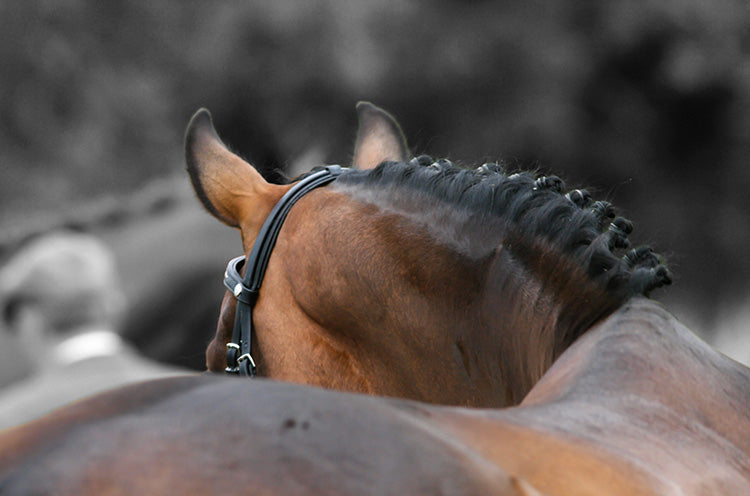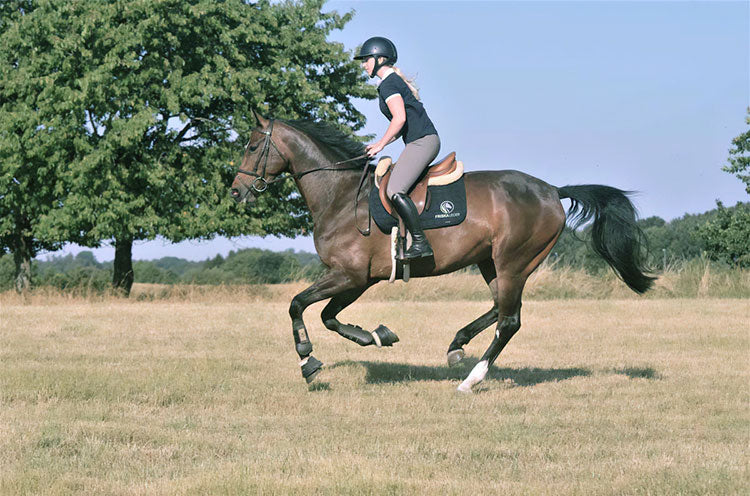In the month of February, we talked to our profile rider Nathalie Bozic.
February is about the theme Building. Nathalie has ridden all her life, she has competed up to 3* international 145cm LR ranking class and works today to train her young horses to the same level. Through hard work, she has taken horses up to difficult jumping in the past and knows what long-term work means. We've asked her a few questions, which she answers below:
What is build-up to you?
For me, it is the building blocks you set as the basis for your set goals. It includes everything such as the feed state, a varied and balanced training plan and knowledge of your horse. In order to be able to build up your horse in the long term, regardless of whether the goal is a healthy horse after rehab, 150cm jumping or to strengthen your horse in the canter, you must get to know your horse to be able to give it the best conditions.
What does building up the competition horse mean?
When building a horse with big classes as the goal, we have to think about all the parts. We want a horse that can cope and is ready for the task. We want a horse that is up to the task and we want a horse that wants to do the task.
By setting intermediate goals and setting up a training plan, you actively work towards the big goal. The sub-goals can be set in a certain type of class and when you want to complete it. Then it's time to plan, what do we need to work on to achieve the set interim goal? How do we do it? When setting up a training plan, it is important to find a balance in training and recovery. Variety of work and ground is also important for the horses, both mentally and physically.
In the training plan, we also have to review factors where the horses' bodies have time to recover and rebuild. If we train hard on the court 6 days a week, neither muscles, joints, ligaments nor anything else will feel good in the long run. It can be motivating to trim and train every day because it feels like you are working hard towards your goal. The problem with monotonous work like this is that it will eventually wear your horse out. It is therefore important to be a little creative in your arrangement. Just as you build up strength in the stable, you also do it effectively on the slopes in the forest.
Another factor in this is the recovery time. Giving the horse time to recover can be as simple as walking him properly after your riding session. Then the joints can naturally recover and transport out slag products instead of standing the horse in the stable aisle where the slag can remain and cause damage. Recovery can also be active rest after a tougher period, where the horse recovers by moving. This is also a matter of the individual. Some horses need longer rest periods between seasons, while other horses do better with more work. Something all the vets I've spoken to agree on is that active rest is always the best option for the healthy horse. It can be easier work in the forest, emptying, whole riding sessions in just walking, yes, only the imagination sets the limits.
Then motivating your horse to enter the track and want to do the job is also connected to the above discussions. A horse that feels strong in its body and prepared will also feel confident about the task. The same applies to the rider. A horse that is, for example, trained to debut its 140cm will find it feels easy. On the other hand, if you enter with a horse that is perhaps too poorly trained physically or is not obedient enough, it will find the task difficult and leave the track with a bad experience. That is why it is so important to have a holistic approach when building your horse. Look at each horse as an individual and find what suits it best. Think of the build-up as steps and everything you do along the way lays the foundation for being able to move up another step.
What does rebuilding after an injury mean?
Recovery after an injury is about gradually building your horse from its injured state back to its normal pain-free/healthy state. During the rehabilitation, it is very important to be thorough and that it can take its time. Otherwise, you run the risk of the injury returning or even getting worse... With the help of advice from your vet and supportive supplements, rebuilding can be relatively easy.
Your 3 best tips on the topic of construction?
- Be patient and let it take time.
Whether it's building performance, from injury or confidence. Ice in the stomach will pay off in the long run. - Dare to get help.
By trainers, vets, experts etc. All knowledge is valuable and thinking you can do it all yourself is just stupid. If you do not agree or feel that it does not work, you can always change the approach. However, I believe that it is always beneficial to turn to someone with experience in the area. - Post a durable
Make sure that you work with the build-up in a way where the body can catch up and keep up. A healthy horse will perform better no matter what the task, it will definitely be happier and your friend will have a longer life. So plan what the training should look like, when you should push and when the recovery periods will come. Set up each session with a balance between hard work and recovery. Support the horse's body with supplements for joints and muscles to avoid stress injuries.




Leave a comment
This site is protected by hCaptcha and the hCaptcha Privacy Policy and Terms of Service apply.